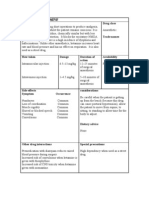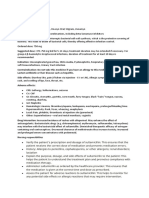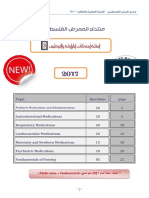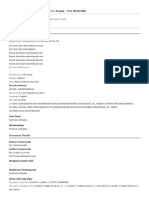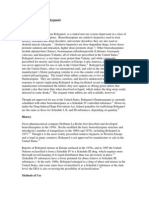Neostigmine
Neostigmine
Uploaded by
Donna Lyn B. DizonCopyright:
Available Formats
Neostigmine
Neostigmine
Uploaded by
Donna Lyn B. DizonCopyright
Available Formats
Share this document
Did you find this document useful?
Is this content inappropriate?
Copyright:
Available Formats
Neostigmine
Neostigmine
Uploaded by
Donna Lyn B. DizonCopyright:
Available Formats
Neostigmine (Prostigmine) Neostigmine is an anticholinesterase drug that is used for most commonly to stimulate muscle control.
. Its action is to competitively inhibits acetylcholine (ACh) from attaching to acetylcholinestase (AChE) binding sites, where ACh is normally broken down by hydrolysis. This allows ACh to persist for a longer period of time enhancing transmission across neuromuscular junctions. Neostigmine is a prescription drug and can only be obtained from a veterinarian or by prescription from a veterinarian. This drug is not approved for use in animals by the Food and Drug Administration but it is prescribed legally by veterinarians as an [[rol||extra-label|The medical use of a drug for a pu rpose or in an animal species other than that approved "on the label" by the FDA (Food and Drug Administration). Many human drugs are used in animals in an extra-label manner.]] drug. Brand Names and Other Names This drug is registered for use in humans only. Human formulations: Prostigmine (ICN) and Neostigmine Methylsulfate (various generic manufacturers/suppliers) Veterinary formulations: None Uses of Neostigmine Reversal of the effects of non-depolarizing neuromuscular blocking agents Symptomatic control in myasthenia gravis Prevention and treatment of post-operative urinary retention (if mechanical blockage has been eliminated as a possible cause) Stimulation of intestinal smooth muscle (increased peristalsis) Reversal of the physiological effects some snake venoms Treatment of ivermectin poisoning Precautions and Side Effects While generally safe and effective when prescribed by a veterinarian, neostigmine can cause side effects in some animals. Neostigmine should not be used in animals with known hypersensitivity or allergy to the drug. Neostigmine should not be used in pregnant animals. In addition, it should be avoided when there is intestinal or urinary tract obstruction or peritonitis. Neostigmine should be used with caution in patients with bronchial asthma (cats), epilepsy, bradycardia, enhanced vagal tone (some brachycephalic dogs), hyperthyroidism (esp. cats), cardiac arrhythmias, and gastric ulcers. Drug Interactions Neostigmine may interact with other medications. Consult with your veterinarian to determine if other drugs your pet is receiving could interact with neostigmine. Such interactions may include: If neostigmine is to be given to patients receiving drugs with weak neuromuscular blocking activity (e.g. aminoglycosides, some antiarrhythmics and anesthetic drugs), its dose may have to be increased. Corticosteroids may decrease neostigmine's anticholinesterase activity. Neostigmine may prolong neuromuscular blockade produced by depolarizing muscle relaxants (e.g. succinylcholine). How Neostigmine is Supplied Neostigmine is available as an injection in a 1:1000 concentration. It is supplied in 1 mL amps and 10 mL vials. Dosing Information Medication should never be administered without first consulting your veterinarian. The dosage prescribed may vary depending on the reason for prescribing. The duration of administration depends on the condition being treated, response to the medication and the development of any adverse effects. Be certain to complete the prescription unless specifically directed by your veterinarian. Even if your pet feels better, the entire treatment plan should be completed to prevent relapse. In dogs and cats with myasthenia gravis, the usual dose is 0.02 mg per pound (0.04 mg/kg) every 6 hours intramuscularly. When used as a smooth muscle stimulant, the usual dose is 0.02 to 0.025 mg per pound (0.04 0.05 mg/kg) subcutaneously or intramuscularly. When used for the reversal of a non-depolarizing neuromuscular block, the dose of neostigmine required for reversal depends on the degree of block present. Because of this, the dose of neostigmine varies widely so it often given in incremental doses 0.005 to 0.01 mg per pound (0.01 - 0.02 mg/kg), while
monitoring for effect. NOTE: *When neostigmine is administered by intravenous injection, atropine may be given several minutes beforehand to counteract unwanted muscarinic side effects such as bradycardia, increased secretions, and bronchoconstriction. MYTELASE (ambenonium chloride) Prescribing Information
DESCRIPTION MYTELASE, brand of ambenonium chloride, is [Oxalylbis (iminoethylene)] bis[(o-chlorobenzyl) diethylammonium] dichloride, a white crystalline powder, soluble in water to 20 percent (w/v). Inactive Ingredients: Acacia, Dibasic Calcium Phosphate, Gelatin, Lactose, Magnesium Stearate, Starch, Sucrose. CLINICAL PHARMACOLOGY The compound is a cholinesterase inhibitor with all the pharmacologic actions of acetylcholine, both the muscarinic and nicotinic types. Cholinesterase inactivates acetylcholine. Like neostigmine, MYTELASE suppresses cholinesterase but has the advantage of longer duration of action and fewer side effects on the gastrointestinal tract. The longer duration of action also results in more even strength, better endurance, and greater residual effect during the night and on awakening than is produced by shorter-acting anticholinesterase compounds. INDICATION AND USAGE This drug is indicated for the treatment of myasthenia gravis. CONTRAINDICATIONS Routine administration of atropine with MYTELASE is contraindicated since belladonna derivatives may suppress the parasympathomimetic (muscarinic) symptoms of excessive gastrointestinal stimulation, leaving only the more serious symptoms of fasciculation and paralysis of voluntary muscles as signs of overdosage. MYTELASE should not be administered to patients receiving mecamylamine, or any other ganglionic blocking agents. MYTELASE should also not be administered to patients with a known hypersensitivity to ambenonium chloride or any other ingredients of MYTELASE. WARNINGS Because this drug has a more prolonged action than other antimyasthenic drugs, simultaneous administration with other cholinergics is contraindicated except under strict medical supervision. The overlap in duration of action of several drugs complicates dosage schedules. Therefore, when a patient is to be given the drug, the administration of all other cholinergics should be suspended until the patient has been stabilized. In most instances the myasthenic symptoms are effectively controlled by its use alone. PRECAUTIONS Great care and supervision are required, since the warning of overdosage is minimal and the requirements of patients vary tremendously. It must be borne in mind constantly that a narrow margin exists between the first appearance of side effects and serious toxic effects. Caution in increasing the dosage is essential. The drug should be used with caution in patients with asthma, Parkinsons disease or in patients with mechanical intestinal or urinary obstruction. Usage in Pregnancy. Safe use of this drug during pregnancy has not been established. Therefore, before use of MYTELASE in pregnant women or women of childbearing potential, the potential benefits should be weighed against possible risks to mother and fetus. Nursing Mothers. It is not known whether this drug is excreted in human milk. Because many drugs are excreted in human milk and because of the potential for serious adverse reactions in nursing infants from MYTELASE, a decision should be made whether to discontinue nursing or to discontinue the drug, taking into account the importance of the drug to the mother.
Pediatric Use. Safety and effectiveness in pediatric patients have not been established. Geriatric Use. Clinical Studies of MYTELASE did not include sufficient numbers of subjects aged 65 and over to determine whether they respond differently from younger subjects. Other reported clinical experience has not identified differences in responses between the elderly and younger patients. In general, dose selection for an elderly patient should be cautious, usually starting at the low end of the dosing range, reflecting the greater frequency of decreased hepatic, renal, or cardiac function, and of concomitant disease or other drug therapy. ADVERSE REACTIONS Adverse effects of anticholinesterase agents such as MYTELASE usually result from overdosage and include muscarinic effects such as excessive salivation, abdominal cramps, diarrhea, miosis, urinary urgency, sweating, nausea, increase in bronchial and lacrymal secretions, and vomiting, and nicotinic effects such as muscle cramps, fasciculation of voluntary muscles, and rarely generalized malaise with anxiety and vertigo. (See OVERDOSAGE.)
DOSAGE AND ADMINISTRATION The oral dose must be individualized according to the patients response because the disease varies widely in its severity in different patients and because patients vary in their sensitivity to cholinergic drugs. Since the point of maximum therapeutic effectiveness with optimal muscle strength and no gastro-intestinal disturbances is a highly critical one, the close supervision of a physician familiar with the disease is necessary. Because its action is longer, administration of MYTELASE is necessary only every three or four hours, depending on the clinical response. Usually medication is not required throughout the night, so that the patient can sleep uninterruptedly. For the patient with moderately severe myasthenia, from 5 mg to 25 mg of MYTELASE three or four times daily is an effective dose. In some patients a 5 mg dose is effective, whereas other patients require as much as from 50 mg to 75 mg per dose. The physician should start with a 5 mg dose, carefully observing the effect of the drug on the patient. The dosage may then be increased gradually to determine the effective and safe dose. The longer duration of action of MYTELASE makes it desirable to adjust dosage at intervals of one to two days to avoid drug accumulation and overdosage. (See OVERDOSAGE.) In addition to individual variations in dosage requirements, the amount of cholinergic medication necessary to control symptoms may fluctuate in each patient, depending on his activity and the current status of the disease, including spontaneous remission. A few patients have required greater doses for adequate control of myasthenic symptoms, but increasing the dosage above 200 mg daily requires exacting supervision of a physician well aware of the signs and treatment of overdosage with cholinergic medication. Edrophonium (Tensilon) may be used to evaluate the adequacy of the maintenance dose of anticholinesterase medication. Two mg edrophonium are administered intravenously one hour after the last anticholinesterase dose. A transient increase in strength occurring about 30 seconds later and lasting 3 to 5 minutes indicates insufficient maintenance dose. If the dose is adequate or excessive, no change or a transient decrease in strength will occur, sometimes accompanied by uscarinic symptoms. OVERDOSAGE When the drug produces over-stimulation, the clinical picture is one of increasing parasympathomimetic action that is more or less characteristic when not masked by the use of atropine. Signs and symptoms of overdosage, including cholinergic crises, vary considerably. They are usually manifested by increasing gastrointestinal stimulation with epigastric distress, abdominal cramps, diarrhea and vomiting, excessive salivation, pallor, pollakiuria, cold sweating, urinary urgency, blurring of vision, and eventually fasciculation and paralysis of voluntary muscles, including those of the tongue (thick tongue and difficulty in swallowing), shoulder, neck, and arms. Rarely, generalized malaise and vertigo may occur. Miosis, increase in blood pressure with or without bradycardia, and finally, subjective sensations of internal trembling, and often severe anxiety and panic may complete the picture. A cholinergic crisis is usually differentiated from the weakness and paralysis of myasthenia gravis insufficiently treated by cholinergic drugs by the fact that myasthenic weakness is not accompanied by any of the above signs and symptoms, except the last two subjective ones (anxiety and panic). Since the warning of overdosage is minimal, the existence of a narrow margin between the first appearance of side effects and serious toxic effects must be borne in mind constantly. If signs of overdosage occur (excessive gastrointestinal stimulation, excessive salivation, miosis, and more serious fasciculations of voluntary muscles) discontinue temporarily all cholinergic medication and administer from 0.5 mg to 1 mg (1/120 to 1/60 grain) of atropine
intravenously. Give other supportive treatment as indicated (artificial respiration, tracheotomy, oxygen, etc.).
You might also like
- OfloxacinDocument2 pagesOfloxacinCarla Arciaga100% (1)
- Sop For Controlled DrugsDocument75 pagesSop For Controlled DrugsBalaji Pharmacy - GMNo ratings yet
- Purdue Liste PDFDocument2 pagesPurdue Liste PDFSebasNo ratings yet
- Nursing Care Plan HF FinalDocument10 pagesNursing Care Plan HF FinalCristina L. JaysonNo ratings yet
- Drug StudyDocument1 pageDrug Studyzjoshuac100% (1)
- UROKINASE (Kinlytic)Document4 pagesUROKINASE (Kinlytic)Mikaela Gabrielle GeraliNo ratings yet
- Acyclovir Drug Study WWW RNpedia ComDocument3 pagesAcyclovir Drug Study WWW RNpedia ComJanaica JuanNo ratings yet
- Drug Study: Notre Dame of Tacurong CollegeDocument2 pagesDrug Study: Notre Dame of Tacurong CollegeApol PenNo ratings yet
- 4th Rot Drug StudyDocument3 pages4th Rot Drug StudyAaron GarciaNo ratings yet
- Epirubicin 10Document1 pageEpirubicin 10PdianghunNo ratings yet
- Cyclobenzaprine Hydrochloride (Drug Study)Document1 pageCyclobenzaprine Hydrochloride (Drug Study)Franz.thenurse6888No ratings yet
- Generic Name:: Norgestimate and Ethinyl EstradiolDocument5 pagesGeneric Name:: Norgestimate and Ethinyl EstradiolJay VillasotoNo ratings yet
- EsmololDocument3 pagesEsmololTri Purma SariNo ratings yet
- Metronidazole 500mg/tab 1 Tab 3xadayDocument4 pagesMetronidazole 500mg/tab 1 Tab 3xadayCrisyl LipawenNo ratings yet
- DRug Study PhenytoinDocument1 pageDRug Study Phenytoinmichelle marquezNo ratings yet
- Drug Study: Loop DiureticDocument5 pagesDrug Study: Loop DiureticNicole Villanueva, BSN - Level 3ANo ratings yet
- ChlorphenamineDocument1 pageChlorphenaminereinaNo ratings yet
- BeclomethasoneDocument2 pagesBeclomethasoneDiane Bonita HerreraNo ratings yet
- Drug Study - KetoprofenDocument3 pagesDrug Study - KetoprofenThalia UyNo ratings yet
- Generic Name: Classification: Indication:: Candida InfectionsDocument1 pageGeneric Name: Classification: Indication:: Candida Infectionscen janber cabrillos0% (1)
- Drug Study: Nursing DepartmentDocument1 pageDrug Study: Nursing Departmentgiselle chloe100% (1)
- ZonisamideDocument2 pagesZonisamideRo-anne AkuNo ratings yet
- Bicalutamide (Casodex) Drug StudyDocument2 pagesBicalutamide (Casodex) Drug StudyAtteya Mogote AbdullahNo ratings yet
- Drug Study: AmoxicillinDocument3 pagesDrug Study: AmoxicillinKrzia TehNo ratings yet
- CALCITRIOLDocument2 pagesCALCITRIOLdesshe09No ratings yet
- Drug Study QIDocument8 pagesDrug Study QImaeDonitaNo ratings yet
- Drug Study Ferrous Sulfate + FADocument3 pagesDrug Study Ferrous Sulfate + FAKristine Champness100% (1)
- DRUG STUDY (Dextromethorphan)Document2 pagesDRUG STUDY (Dextromethorphan)Avianna CalliopeNo ratings yet
- Timolol MaleateDocument3 pagesTimolol MaleateAP TOROBXNo ratings yet
- Medication Mechanism of Action Indication Contraindication Adverse Drug Reaction GenericDocument1 pageMedication Mechanism of Action Indication Contraindication Adverse Drug Reaction GenericTrisha CayabyabNo ratings yet
- Drug Study (Pe)Document15 pagesDrug Study (Pe)Jobelle AcenaNo ratings yet
- SHEENA Clomid Drug StudyDocument3 pagesSHEENA Clomid Drug StudyNur SetsuNo ratings yet
- Drug StudyDocument5 pagesDrug StudyGAYOL BREEN IRAH A.No ratings yet
- Drug StudyDocument1 pageDrug StudySheryll Anne MolartoNo ratings yet
- Drug StudyDocument6 pagesDrug StudySa Dei100% (1)
- Drug StudyDocument4 pagesDrug Studysnowyfingers100% (1)
- Chlorpheniramine Maleate: (klor-fen-AIR-uh-meen MAL-ee-ate)Document4 pagesChlorpheniramine Maleate: (klor-fen-AIR-uh-meen MAL-ee-ate)Nurginayah RusliNo ratings yet
- PhenobarbitalDocument1 pagePhenobarbitalSherwin LauronNo ratings yet
- Clotrimazole Cream Lotion Solution Dusting PowderDocument4 pagesClotrimazole Cream Lotion Solution Dusting Powderedy744No ratings yet
- DORMICUMDocument1 pageDORMICUMArian Rose100% (1)
- Drug Study (Acetaminophen)Document1 pageDrug Study (Acetaminophen)Kian HerreraNo ratings yet
- Drug-Study-Metformin 1Document2 pagesDrug-Study-Metformin 1Caroline Cha100% (1)
- Pyrazinamide Drug StudyDocument1 pagePyrazinamide Drug Studyanreilegarde100% (2)
- NitrofurantoinDocument3 pagesNitrofurantoinapi-3797941No ratings yet
- DS PiptazDocument1 pageDS PiptazCristel Z. Gabuco100% (1)
- BNP (C)Document2 pagesBNP (C)Mae Ann Bueno CastillonNo ratings yet
- OxcarbazepineDocument4 pagesOxcarbazepineahmad_makhtarNo ratings yet
- Drug NystatinDocument1 pageDrug NystatinSrkocherNo ratings yet
- Drug Study For MGDocument1 pageDrug Study For MGSandra MedinaNo ratings yet
- FINAL Drug StudyDocument2 pagesFINAL Drug StudycasedraftNo ratings yet
- Drug Study - LevothyroxineDocument1 pageDrug Study - LevothyroxineCarla Tongson MaravillaNo ratings yet
- Drug StudyDocument13 pagesDrug StudygemzkeeNo ratings yet
- Atropine SulfateDocument2 pagesAtropine SulfateKureaa OhNo ratings yet
- Aspirin: Generic NameDocument4 pagesAspirin: Generic NameGwww BabababaNo ratings yet
- Tetanus Toxoid For Booster Use Only: (Not Recommended For Primary Immunization)Document5 pagesTetanus Toxoid For Booster Use Only: (Not Recommended For Primary Immunization)Ade PurnaNo ratings yet
- DocetaxelDocument4 pagesDocetaxelfnurdiansah002No ratings yet
- Drug Study SulfasalazineDocument2 pagesDrug Study SulfasalazineBunnie AlphaNo ratings yet
- Drug Study...Document5 pagesDrug Study...Ezra Dizon ManzanoNo ratings yet
- KETAMINEDocument2 pagesKETAMINERPh Krishna Chandra JagritNo ratings yet
- Silver Sulfadiazine Drug StudyDocument3 pagesSilver Sulfadiazine Drug StudyKenn Siasar100% (1)
- Drugs Study Pedia PDFDocument8 pagesDrugs Study Pedia PDFmark angeloNo ratings yet
- Neuropathic Pain Diabetic Peripheral NeuropathyDocument7 pagesNeuropathic Pain Diabetic Peripheral NeuropathyJomabee TuArNo ratings yet
- Pyridostigmine BromideDocument4 pagesPyridostigmine BromideRavinderenPichan100% (1)
- Evaluation of Cleaning Method Validation Techniques of PioglitazoneDocument11 pagesEvaluation of Cleaning Method Validation Techniques of PioglitazoneGaoussou TimitéNo ratings yet
- Bullets: (Fundamentals of Nursing)Document71 pagesBullets: (Fundamentals of Nursing)FayePalmes100% (2)
- Marijuana Equivalency in Portion and DosageDocument44 pagesMarijuana Equivalency in Portion and DosagesaludemosNo ratings yet
- ملزمة منتدي الممرض الفلسطيني 2017 NewDocument37 pagesملزمة منتدي الممرض الفلسطيني 2017 Newأبوأحمد الحكيمNo ratings yet
- Clinical Pathway: Perhimpunan Dokter Spesialis Anestesiologi Dan Terapi Intensif Indonesia 2013Document43 pagesClinical Pathway: Perhimpunan Dokter Spesialis Anestesiologi Dan Terapi Intensif Indonesia 2013tar1195No ratings yet
- Aleisha Frazier Health Summary 08172018Document49 pagesAleisha Frazier Health Summary 08172018ajmcgeefrazierNo ratings yet
- St. Xavier Letter To Parents About Drug TestingDocument2 pagesSt. Xavier Letter To Parents About Drug TestingCameron KnightNo ratings yet
- Assignment 3Document29 pagesAssignment 3puiyeeeeNo ratings yet
- Adverse Drug Reactions and Drug InteractionsDocument10 pagesAdverse Drug Reactions and Drug Interactions88AKKNo ratings yet
- IKAFI - DPP4 InhibitorDocument25 pagesIKAFI - DPP4 InhibitorYuliarni Hasan100% (1)
- RohypnolDocument4 pagesRohypnolms15No ratings yet
- Adverse Effects of Anti Tubercular Drugs. MDR TBDocument75 pagesAdverse Effects of Anti Tubercular Drugs. MDR TBDr.U.P.Rathnakar.MD.DIH.PGDHM100% (1)
- Erythromycin Drug StudyDocument2 pagesErythromycin Drug StudyJude LabajoNo ratings yet
- United States v. Marks, 365 F.3d 101, 1st Cir. (2004)Document8 pagesUnited States v. Marks, 365 F.3d 101, 1st Cir. (2004)Scribd Government DocsNo ratings yet
- Coreg (Carvedilol) 6.25mgDocument3 pagesCoreg (Carvedilol) 6.25mgE100% (2)
- Emergency Homeopathic TreatmentDocument613 pagesEmergency Homeopathic TreatmentSashikant Modi100% (1)
- SteroidsDocument2 pagesSteroidsShawn FreemanNo ratings yet
- Kidneys Largeprint 508Document28 pagesKidneys Largeprint 508Puji Arifianti RamadhanyNo ratings yet
- Acute Pain Related To Tissue Trauma Due To Surgical Procedure Done (Thoracentesis)Document6 pagesAcute Pain Related To Tissue Trauma Due To Surgical Procedure Done (Thoracentesis)Jasmine Ruth ValdezNo ratings yet
- Pdrugs and P TreatmentDocument66 pagesPdrugs and P TreatmentPoppy Pradina0% (1)
- Sinupret patientInfoSheetDocument1 pageSinupret patientInfoSheetiisisiis100% (1)
- AutacoidsDocument3 pagesAutacoidsaymanbassyouni77No ratings yet
- Detrol (Tolterodine)Document1 pageDetrol (Tolterodine)ENo ratings yet
- Hashish! Need Full VersionDocument15 pagesHashish! Need Full Versiontyson0% (1)
- Australian Asthma Handbook Quick ReferenceGuide - Version1.0Document44 pagesAustralian Asthma Handbook Quick ReferenceGuide - Version1.0butterwalkerNo ratings yet
- IP Monographs Development by IPCDocument86 pagesIP Monographs Development by IPCNitinPrachiJainNo ratings yet
- Crash Cart Checklist (Perso) : East Jeddah HospitalDocument4 pagesCrash Cart Checklist (Perso) : East Jeddah HospitalSam AlrabigiNo ratings yet


























































